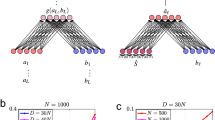Abstract
This paper presents new approaches to form knowledge and achieve generalization and creativity in a human-like way using artificial associations in artificial neural associative systems. We can assume that knowledge is automatically formed in a human brain that is able to associate many objects, facts, rules, needs, and emotions. The brain structure is very specific and does not reflect architectures of today’s computers. This paper describes a neuronal structure that is able to represent various data combinations and their sequences in an aggregated form, which allows to recall consolidated facts and rules by triggering various neuron combinations. New combinations of initially triggered neurons recall even new facts and rules as a result of high-level generalization that can be treated as creative behavior. This paper provides the description of artificial neural associative systems that enable to create knowledge in a human-like associative way and to trigger artificial associations.
Access this chapter
Tax calculation will be finalised at checkout
Purchases are for personal use only
Similar content being viewed by others
References
Alberts, B., Bray, D., Hopkin, K., Johnson, A., Lewis, J., Raff, M., Roberts, K., Walter, P.: Basics of Cell Biology. PWN, Warsaw (2007)
Duch, W.: Creativity and the Brain, In: A Handbook of Creativity for Teachers. Ed. Ai-Girl Tan, pp. 507–530. World Scientific Publishing, Singapore (2007)
Horzyk, A.: Artificial Associative Systems and Associative Artificial Intelligence. pp. 1–276. EXIT, Warsaw (2013)
Horzyk, A.: Information Freedom and Associative Artificial Intelligence. LNAI, vol. 7267, pp. 81–89. Springer, Berlin (2012)
Horzyk, A.: How Does Human-Like Knowledge Come into Being in Artificial Associative Systems, pp. 189–200. Proceedings of International Conference on Knowledge, Information and Creativity Support Systems (2013)
Horzyk, A.: How Does Generalization and Creativity Come into Being in Neural Associative Systems and How Does It Form Human-Like Knowledge, pp. 238–257. Neurocomputing (2014)
Kalat, J.W.: Biological Grounds of Psychology. PWN, Warsaw (2006)
Kossut, M.: The Mechanisms of Brain Plasticity. PWN, Warsaw (1993)
Lachwa, A.: Fuzzy World Harvest, Numbers, Relationships, Facts, Rules, and Decisions. EXIT, Warsaw (2001)
Larose, D.T.: Discovering Knowledge From Data. Introduction to Data Mining. PWN, Warsaw (2006)
Ligeza, A., Kluza, K., Nalepa, G.J., Potempa, T.: Artificial intelligence for knowledge management with BPMN and rules. Proc. AI4KM (2012)
Longstaff, A.: Neurobiology. PWN, Warsaw (2006)
Maass, W.: Networks of spiking neurons: the third generation of neural network models. Neural Netw. 10, 1659–1671 (1997)
Papadimitriou, C.H.: Computational Complexity. WNT, Warsaw (2002)
Schmidhuber, J.: Developmental robotics, optimal artificial curiosity, creativity, music, and the fine arts. Connect. Sci. 18(2), 173–187 (2006)
Skulimowski, A.M.J.: Freedom of Choice and Creativity in Multicriteria Decision Making. LNAI, vol. 6746, pp. 190–203. Springer, Berlin (2011)
Skulimowski, A.M.J.: Anticipatory network models of multicriteria decision-making processes. Int. J. Syst. Sci. 45(1), 39–59 (2014)
Skulimowski, A.M.J.: Hybrid anticipatory networks. In: Proceedings of 11th International Conference ICAISC 2012, LNAI, vol. 7268, pp. 706–715. Springer, Berlin (2012)
Tadeusiewicz, R., Korbicz, J., Rutkowski, L., Duch, W. (eds.): Neural networks in biomedical engineering. In: Monograph: Biomedical Engineering—Basics and Applications, vol. 9. Exit, Warsaw (2013)
Tadeusiewicz, R.: New trends in neurocybernetics. Comput. Methods Mater. Sci. 10(1), 1–7 (2010)
Tadeusiewicz, R., Figura, I.: Phenomenon of tolerance to damage in artificial neural networks. Comput. Methods Mater. Sci. 11(4), 501–513 (2011)
Tadeusiewicz, R.: Neural Networks as Computational Tool with Interesting Psychological Applications, Chapter in book: Computer Science and Psychology in Information Society, pp. 49–101. AGH Printing House, Krakow (2011)
Thaler, S.L.: The Creativity Machine Paradigm, In: Carayannis, E.G. (ed.) Encyclopedia of Creativity, Invention, Innovation, and Entrepreneurship. Springer (2013)
Wulfram, G., Werner, M.K.: Spiking Neuron Models. Single Neurons, Populations, Plasticity. Cambridge University Press, Cambridge (2002)
Author information
Authors and Affiliations
Corresponding author
Editor information
Editors and Affiliations
Rights and permissions
Copyright information
© 2016 Springer International Publishing Switzerland
About this paper
Cite this paper
Horzyk, A. (2016). Human-Like Knowledge Engineering, Generalization, and Creativity in Artificial Neural Associative Systems. In: Skulimowski, A., Kacprzyk, J. (eds) Knowledge, Information and Creativity Support Systems: Recent Trends, Advances and Solutions. Advances in Intelligent Systems and Computing, vol 364. Springer, Cham. https://doi.org/10.1007/978-3-319-19090-7_4
Download citation
DOI: https://doi.org/10.1007/978-3-319-19090-7_4
Published:
Publisher Name: Springer, Cham
Print ISBN: 978-3-319-19089-1
Online ISBN: 978-3-319-19090-7
eBook Packages: Computer ScienceComputer Science (R0)




